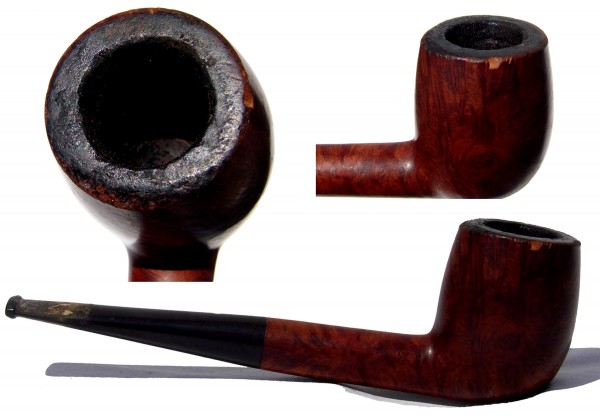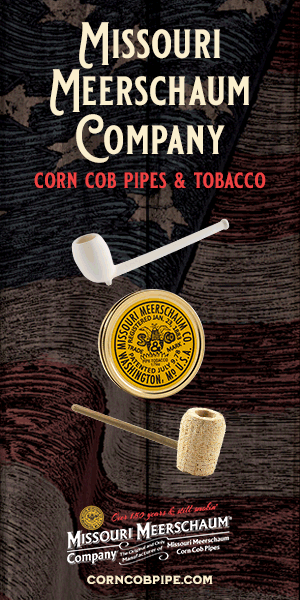In my journey to find a birth year Dunhill, which I wrote about in a previous post, something awoke in me that I hadn't previously known to be there, mainly because I never looked into estate pipes, always buying new. But obviously that was going to change if I wanted a pipe from 1971. And that something was an interest in acquiring an old pipe of historical significance either to me (like a birth year) or just in general. Obviously I was not planning on ponying up the cash for "General MacArthur's pipe from the famous picture" or anything crazy like that, but something like a pipe from the Depression, or WWII, or my mom or dad's birth year, just something a little older than 1971. Being a student of history, I just find tokens and rememberances of the past to be interesting.
Obviously I was going to again have to turn to Dunhills since they are the only ones that you can accurately acertain their manufacturing year, though some of it is akin to interpreting hierogliphics. I wasn't looking for anything specific, just poking around through eBay, and I found a pipe from 1942, which I thought was a cool find considering it was a Dunhill, made in England, during the "turning point year" of World War II. Plus I know that pipe manufacturing took a back seat to the war industries and as a result Dunhill production was down in those years...not saying I have a collector's item or anything, but never the less, a cool item. It's a Root Briar Billiard 34 2R Group 2...and I have to say I got this 70 year old for less than any of my other pipes.
Now the other two Dunhill estates I bought arrived in pristine condition, and I didn't really have to do anything to them. This one on the hand had obviously been used, and not restored, but then that also accounted for the lower price, and since I have an interest in learning the restoration process, it was kind of a win win for me.
This one is used, with lots of cake and rim char/cake, and a little ding out the rim, and some oxidation and teeth marks on the stem.

Surprisingly, it actually arrived in better shape than the pictures make it look, but never the less it will need some work...and while this seems like a cool one to learn on, since structurely everything is good with the pipe, I also don't want to screw it up. So after having gathered information over the years (but never done a restore) I'm going to post what I plan on doing, and let me if that sounds about right to you:
Stem
1. Cover the dot with vaseline and soak it in bleach for however long that takes. Rinse.
2. Use as many bristle pipe cleaners soaked in Everclear as needed until they come out clean.
3. Use Micro Mesh through the whole range of grits to get the stem and the teeth marks cleaned up and shiny
4. Use a stem polish to finish the job
Bowl lip (to get off the char/cake)
1. Do the cotton pad/paper towel soaked in Everclear and then inverting the pipe on the towel with just the lip in contact trick to loosen/remove the charring.
2. Not sure about the ding in the lip, or the roughness around the edge...should I leave as is, or should I try using some Micro Mesh to even it out? Or would you leave it as "character"?
Bowl and shank
3. Going to ream the cake, preferably back to the wood, but will be careful not to be too aggressive.
4. Will use a shank brush, bristle pipe cleaners, and Q-tips with Everclear to clean out the shank and airhole area.
5. Then I will do the Salt and Everclear procedure on the bowl/shank
Anything I am leaving out or forgetting? Or attempting stuff I shouldn't? Would you smooth out the lip or leave as is? If you sand it, how do you match the stain, because I am sure through the cleaning of the lip area some will come off? I do have some Cherry and Walnut stains...they might match well, especially in small areas. Worst case scenario is that I just clean up the stem and then just have it as a look at, but not smoke pipe.
Obviously I was going to again have to turn to Dunhills since they are the only ones that you can accurately acertain their manufacturing year, though some of it is akin to interpreting hierogliphics. I wasn't looking for anything specific, just poking around through eBay, and I found a pipe from 1942, which I thought was a cool find considering it was a Dunhill, made in England, during the "turning point year" of World War II. Plus I know that pipe manufacturing took a back seat to the war industries and as a result Dunhill production was down in those years...not saying I have a collector's item or anything, but never the less, a cool item. It's a Root Briar Billiard 34 2R Group 2...and I have to say I got this 70 year old for less than any of my other pipes.
Now the other two Dunhill estates I bought arrived in pristine condition, and I didn't really have to do anything to them. This one on the hand had obviously been used, and not restored, but then that also accounted for the lower price, and since I have an interest in learning the restoration process, it was kind of a win win for me.
This one is used, with lots of cake and rim char/cake, and a little ding out the rim, and some oxidation and teeth marks on the stem.

Surprisingly, it actually arrived in better shape than the pictures make it look, but never the less it will need some work...and while this seems like a cool one to learn on, since structurely everything is good with the pipe, I also don't want to screw it up. So after having gathered information over the years (but never done a restore) I'm going to post what I plan on doing, and let me if that sounds about right to you:
Stem
1. Cover the dot with vaseline and soak it in bleach for however long that takes. Rinse.
2. Use as many bristle pipe cleaners soaked in Everclear as needed until they come out clean.
3. Use Micro Mesh through the whole range of grits to get the stem and the teeth marks cleaned up and shiny
4. Use a stem polish to finish the job
Bowl lip (to get off the char/cake)
1. Do the cotton pad/paper towel soaked in Everclear and then inverting the pipe on the towel with just the lip in contact trick to loosen/remove the charring.
2. Not sure about the ding in the lip, or the roughness around the edge...should I leave as is, or should I try using some Micro Mesh to even it out? Or would you leave it as "character"?
Bowl and shank
3. Going to ream the cake, preferably back to the wood, but will be careful not to be too aggressive.
4. Will use a shank brush, bristle pipe cleaners, and Q-tips with Everclear to clean out the shank and airhole area.
5. Then I will do the Salt and Everclear procedure on the bowl/shank
Anything I am leaving out or forgetting? Or attempting stuff I shouldn't? Would you smooth out the lip or leave as is? If you sand it, how do you match the stain, because I am sure through the cleaning of the lip area some will come off? I do have some Cherry and Walnut stains...they might match well, especially in small areas. Worst case scenario is that I just clean up the stem and then just have it as a look at, but not smoke pipe.







